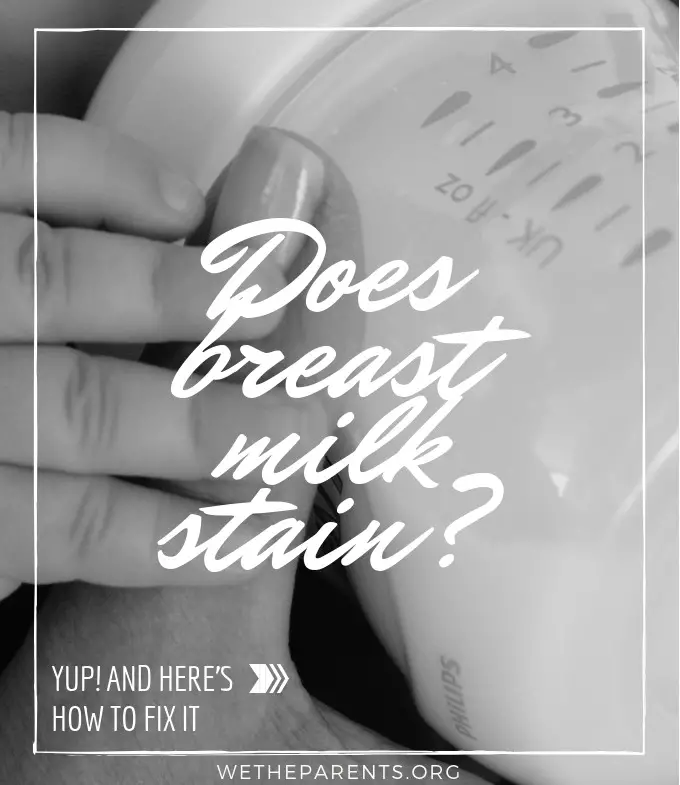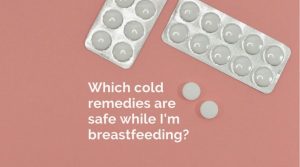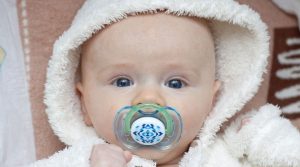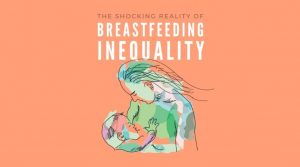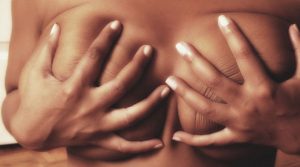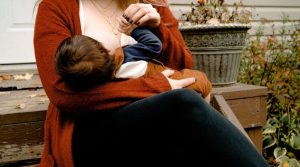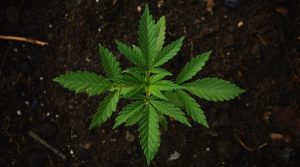“Did the dog pee on the laundry?!” I nearly shrieked, rifling through the pile of clothing that I had just washed. She must have; why else would there be yellow stains on my baby’s bibs, onesies, and…everything else? I knew I shouldn’t have left the clothes sitting on the couch…
Well, truth be told, the dog was innocent! The cause of the stains? Me, myself, and baby; it turns out that breast milk can turn any fabric a lovely shade of yellow, even after it’s been through the wash.
Does this mean that all babies are destined to wear splotchy, stained clothing for their entire nursing life? Not at all. With the right method, you can get those stains out of fabric, and keep them out.
So let’s talk about breast milk stains.
Why does breast milk stain?
You would be hard-pressed to find a mother who doesn’t know that breastfeeding is healthy, but do you know exactly why?
Nature has made our bodies capable of producing breast milk that’s not only rich in vitamins but also contains the much-needed fat and protein your baby needs. It’s the ideal concoction for your child’s early meals, and you don’t even have to wait in a checkout line to buy it.
But here’s the rub; those proteins are responsible for the icky yellow tint that a breast milk stain can leave behind. And how about the (not so) occasional ‘greasy’ stain? Yep, that comes from the fatty part of your breast milk. It turns out good nutrition can be messy!1Jenness, R. (1979, July). The composition of human milk. In Seminars in perinatology (Vol. 3, No. 3, pp. 225-239).
europepmc.org
Editor’s Note:
Did you know the contents and color of your breast milk can change every day, or even throughout the day? Normal breast milk can be yellow, white, clear, or even have a bluish tint to it. The color of milk is determined by mom’s diet, the time of day (fat content varies throughout the day), and even antibodies, if your baby is fighting off infection.2Color of Milk
llli.org/breastfeeding-info/color-of-milk/
What about colostrum?
Your body’s natural amuse-bouche, colostrum, is produced during pregnancy, and for 2 to 5 days after you give birth. It will then blend with breast milk for about 10 to 14 days before the complete transition to breast milk takes place, at which point colostrum disappears off the menu altogether.3Weiner, L. Y. (1994). Reconstructing motherhood: the la leche league in postwar America. 1357-1381.The Journal of American History, 80(4), 926-934.
lllusa.org
One of the primary benefits of colostrum is that it’s jammed full of protein. Great for your baby, not so great for that snow white onesie because, as we’ve discussed above, protein is quick to leave unsightly stains on fabric.4The Mind-Blowing Superfood for Your Baby
mamanatural.com/colostrum/
Related: 5 Go-To Recipes for Breastfeeding Moms
Getting rid of stains
The methodology behind removing stains is actually pretty straightforward, and something we’ll discuss shortly. Before we get to the fun stuff, however, let’s brush up on some baby laundry tips.
Detergent type
Broadly speaking, there are two kinds of detergents from which to choose.
- Biological detergents: These contain enzymes, and enzymes are troopers when it comes to breaking down a protein stain. They can also deliver a perfectly good clean in cooler water temperatures. However, these enzymes may also be a skin irritant, so some parents bypass this type of product, especially when washing their baby’s clothes.
- Non-Biological detergents: Perfectly capable of taking on tough stains, these detergents do not contain protein-attacking enzymes. You’ll need to use higher water temperatures for a thorough clean, while some believe these detergents are easier on the skin.
Many popular brands make both biological and non-biological versions of their laundry detergents.5Laundry Care Guide for Breastmilk Stains
charlottekeating.com/blogs/news/16404909-laundry-care-guide-for-breastmilk-stains
Pretreatment options
Odds are, you’ll encounter a stain that’s stubborn enough to need soaking in something stronger than cold water. In which case, you may be wondering what, exactly, is safe enough for your baby. Many parents have experienced exceptional results from using:
OxiClean baby stain remover: free of dyes and chlorine, this oxygen-based cleaner has earned a favorable reputation.
Dawn ultra dishwashing liquid dish soap: an oldie but goodie, this is a classic cleaner for those greasy stains.
Dreft laundry stain remover: another industry-standard among parenting circles, this stain remover can do its work in virtually any water temperature.
If synthetic cleaners aren’t really your thing, no worries. There are plenty of natural products that fight stains. A few that are known to help with breast milk blemishes are:
- Lemon or Lime juice: acts as a natural bleach with none of the chemical fallout; just be sure to make sure it’s 100% juice and only use it on your whites.67 Natural Laundry Stain Removers
homeguides.sfgate.com/homemade-laundry-stain-cleaner-ideas-79216.html - White Vinegar: add about 1/4 cup to your normal wash cycle for some extra cleaning and brightening power.7Homemade Laundry Stain Cleaner Ideas
thespruce.com/natural-laundry-stain-removers-4061242 - Hydrogen Peroxide: although eco-friendly and capable of cutting through stains, you might find it doesn’t get through greasy spots as well as some of its product peers.85 Reasons to Use Hydrogen Peroxide for Laundry
thespruce.com/reasons-to-use-hydrogen-peroxide-2145991 - Baking Soda: add four tablespoons of baking soda to 1/4 cup of water, and voila, you have an all-purpose stain remover.9Homemade Laundry Stain Cleaner Ideas
omeguides.sfgate.com/homemade-laundry-stain-cleaner-ideas-79216.html
What about bleach?
It can be tempting to just toss everything in the washer, along with a healthy dose of bleach, and call it a day. But, frustrating as breast milk stains can be, we advise you to put the bleach down and step away from the washer.
Bleach is harsh. Fun fact: it can actually break down polymers that give certain outfits, including some baby clothes, their fire retardant properties.10Registering for Baby Clothes
healthychildren.org/English/ages-stages/prenatal/decisions-to-make/Pages/Choosing-a-Layette.aspx
Moreover, bleach can irritate your baby’s delicate skin. If you do resort to using bleach, be sure to run the laundry load through an extra rinse cycle or two.
Related: Which cold remedies are safe while breastfeeding?
Removing fresh breast milk stains
If you can immediately address a milk spill, it will, of course, be much easier to remove. So, if the planets align and you can act quickly:
- Rinse off the breast milk with cold water.
- Soak the garment for at least 15 minutes in cold water. This will help break down the stain and prevent it from setting into the fabric.
- Work the stain with your fingers or a soft-bristled brush (like a toothbrush), taking care, not to overstretch or otherwise damage the fabric.
- Wash the garment as per the label instructions.
- Dry in the sun to harness Mother Nature’s natural bleaching powers.
Removing set-in breast milk stains
Let’s assume that, because you’re pretty busy raising a member of the next generation, you’re not always able to drop everything and soak a fresh colostrum stain in cold water. In which case:
- Rinse off the area as best you can. If there’s any crusty residue left, gently scrape it away.
- Pretreat the fabric by spraying your product of choice on the stain.
- Use a soft-bristled brush (such as a toothbrush), gently working the pretreatment into the stain.
- Allow the pretreatment to sit on the fabric for at least fifteen minutes, though feel free to wait a full 24 hours or more if your pretreatment allows for it.
- Wash as per the garment label’s instructions.
- Dry in the sun. Remember, it’s the most natural bleach in the world.
Be prepared to wash, rinse, and repeat as needed. Stains are stubborn little beasts, but, with a little elbow grease, you can soon get those fabrics looking bright and clean again.
Related: Breastfeeding vs Pumping (Pros & Cons)
What about mom’s clothes?
It’s not just the baby’s clothes that are going to take a breast milk beating from time to time. Odds are, you’ll have stained shirts, sheets, and bras just begging to step through that washer door.
The good news is, all of the above will work for your clothes as well. So simply:
- Rinse off the breast milk.
- Pretreat your fabric.
- Gently rub with a soft-bristled brush.
- Allow the pretreatment to soak in.
- Wash as per the garment label’s instructions;
- Dry in the sun, the most natural bleach.
While it might be tempting to use detergents designed for serious stain-fighting business, remember that your baby’s bare skin will always be in contact with your body and clothing. To avoid accidentally passing along something that can irritate their delicate skin, we advise parents to stick with milder products, whenever possible.
Editor’s Note:
It’s normal for breast milk to come out of both breasts simultaneously (with baby feeding on one side and the other side spraying or dripping freely), which is where a lot of staining on mom’s clothes or sheets come from. Absorbent pads for your bra work well to soak it up and prevent stains, but, when thrown away, are a waste of liquid gold! Invest in some reusable silicone cups to catch excess milk and store it for later!
Wrapping up
Remember, improperly treated milk stains can remain on clothing, even after completing a normal wash cycle. To avoid this, be sure to master your rinse, pretreat, and scrubbing skills; you don’t want those stains suddenly reappearing when you’re putting away clean laundry.
And, seriously, that dog looked side-eyed at me for months!


